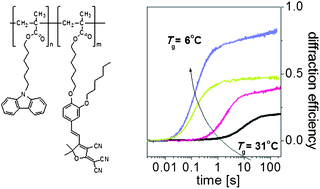New multifunctional copolymers containing carbazole units and high loads of dicyanomethylenedihydrofuran (DCDHF) were synthesized and used to prepare blends for photorefractive (PR) purposes. The materials response, which is strongly dependent on the glass-transition temperature (Tg), was thoroughly analyzed by holography, conductivity and ellipsometry measurements in order to both determine the limiting factors and optimize the performance. Materials that have a Tg around room temperature show strongly hindered chromophore orientation, which is avoided by lowering the Tg down to 6 °C, without compromising the PR effect or the material stability. A further DCDHF-containing homopolymer without carbazole was synthesized and characterized, showing an inferior PR response, which is attributed to a beneficial role for charge generation and transport of the attached carbazole in the copolymers. The new blends strongly improve the structural properties of previous DCDHF-based materials, allowing application of fields well above 100 V μm−1 and preventing beam fanning. Outstanding PR performance was achieved, with fast buildup and erasure times of a few tens of milliseconds (even at low recording intensities), large refractive index modulation (over 10−2) and two-beam coupling gain (above 350 cm−1). Such performance is among the best reported for PR materials based on multifunctional and nonlinear polymers and comparable to standard PR composites.

